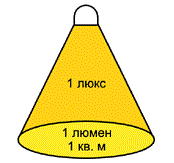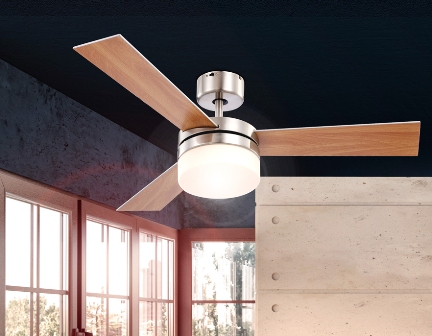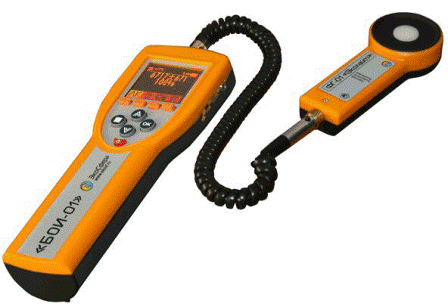Categories: Featured Articles » Sources of light
Number of views: 32516
Comments on the article: 3
What is illumination
 Any light source is a source of light flux, and the larger the light flux falls on the surface of the illuminated object, the better this object is visible. And the physical quantity, numerically equal to the luminous flux incident on a unit area of the illuminated surface, is called illumination.
Any light source is a source of light flux, and the larger the light flux falls on the surface of the illuminated object, the better this object is visible. And the physical quantity, numerically equal to the luminous flux incident on a unit area of the illuminated surface, is called illumination.
Illumination is denoted by the symbol E, and its value is found by the formula E = Ф / S, where Ф is the light flux, and S is the area of the illuminated surface. In the SI system, illumination is measured in Luxes (Lx), and one Lux is such illumination at which the luminous flux incident on one square meter of the illuminated body is equal to one Lumen. That is, 1 Lux = 1 Lumen / 1 Sq.m.
For example, here are some typical illumination values:
-
Sunny day in the middle latitudes - 100,000 Lx;
-
Cloudy day in the middle latitudes - 1000 Lux;
-
Bright room, lit by the rays of the sun - 100 Lx;
-
Artificial lighting on the street - up to 4 Lux;
-
Light at night with a full moon - 0.2 Lx;
-
The light of the starry sky on a dark moonless night - 0.0003 Lx.
Imagine that you are sitting in a dark room with a flashlight and trying to read a book. For reading, you need illumination of at least 30 Lux. What will you do? First, you bring the flashlight closer to the book, which means that the illumination is related to the distance from the light source to the illuminated object. Secondly, you place the flashlight at a right angle to the text, which means that the illumination also depends on the angle at which this surface is illuminated. Thirdly, you can just get a more powerful flashlight, because it is obvious that the illumination is greater, the higher the light intensity of the source.

Suppose a luminous flux hits a screen located at some distance from a light source. We double this distance, then the illuminated part of the surface will increase in area by 4 times. Since E = F / S, then the illumination will decrease by as much as 4 times. That is, the illumination is inversely proportional to the square of the distance from the point source of light to the illuminated object.
When the light beam falls at a right angle to the surface, the light flux is distributed over the smallest area, but if the angle is increased, the area will increase, and accordingly, the illumination will decrease.

As noted above, illumination is directly related to the power of light, and the greater the power of light, the greater the illumination. It has long been established experimentally that illumination is directly proportional to the light intensity of the source.
Of course, illumination is reduced if fog, smoke or dust particles impede light, but if the illuminated surface is at right angles to the light of the source, and the light propagates through clean, transparent air, then the illumination is determined directly by the formula E = I / R2, where I is the light intensity, and R is the distance from the light source to the illuminated object.

In America and England, they use the lumen unit of measure per square foot or foot candela, as the unit of illumination from a source having a luminous intensity of one candela and located one foot from the illuminated surface.
Researchers have proven that through the retina of the human eye, light acts on the processes in the brain. For this reason, insufficient illumination causes drowsiness, inhibits working capacity, and excessive illumination - on the contrary, excites, helps to include additional resources of the body, however, wearing them out if this happens unjustifiably.
During the daily operation of lighting installations, a decrease in illumination is possible, therefore, to compensate for this drawback, a special safety factor is introduced at the stage of designing lighting installations. It takes into account low light and brightness during operation of lighting devices due to pollution, loss of reflective and transmission properties of reflective, optical, and other elements of artificial lighting devices. Pollution of surfaces, failure of lamps, all these factors are taken into account.

For natural lighting, a coefficient of reduction of KEO (coefficient of natural illumination) is introduced, because over time, translucent fillers of light openings may become dirty, and reflective surfaces of rooms can become dirty.
The European standard defines the lighting standards for different conditions, for example, if small details are not required in the office, then 300 Lx is enough, if people work at a computer, 500 Lx is recommended, if drawings are made and read, 750 Lx.

Illumination is measured with a portable device - a light meter. Its principle of operation is similar to a photometer. The light falls on photocellstimulating the current in the semiconductor, and the magnitude of the current obtained is just proportional to the illumination. There are analog and digital light meters.
Often the measuring part is connected to the device with a flexible spiral wire so that it is possible to carry out measurements in the most inaccessible, while important places. A set of light filters is attached to the device to adjust the measurement limits taking into account the coefficients. According to GOST, the error of the device should be no more than 10%.
When measuring, observe the rule that the device should be placed horizontally. It is installed in turn at each necessary point, according to the GOST R 54944-2012 scheme. In GOST, among other things, security lighting, emergency lighting, emergency lighting and semi-cylindrical lighting are taken into account, the measurement method is also described there.
Measurements on artificial and natural are carried out separately, while it is important that a random shadow does not fall on the device. Based on the results obtained, using special formulas, a general assessment is made and a decision is made whether something needs to be adjusted or whether the lighting of the room or territory is sufficient.
See also on this topic: What is light return
See also at bgv.electricianexp.com
:
